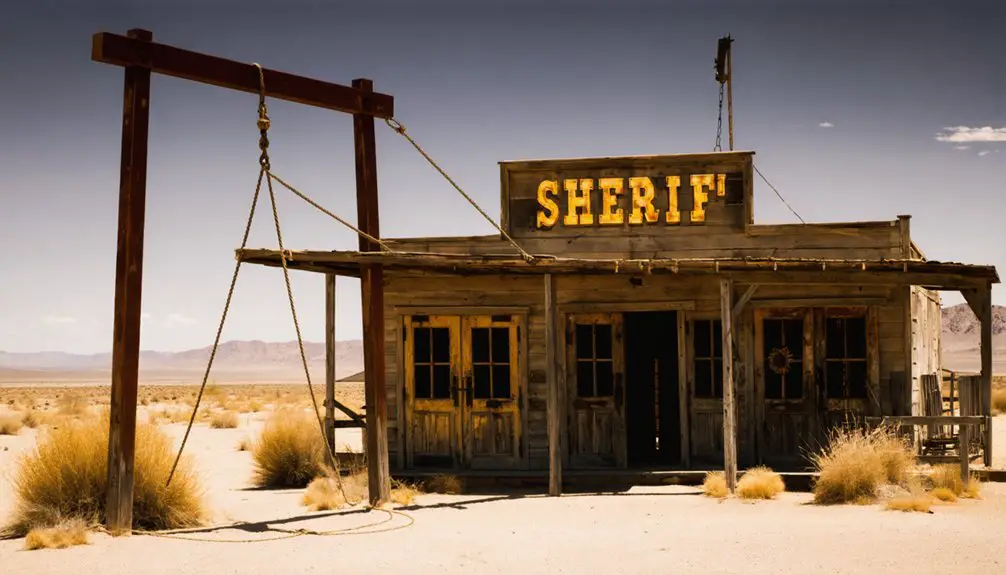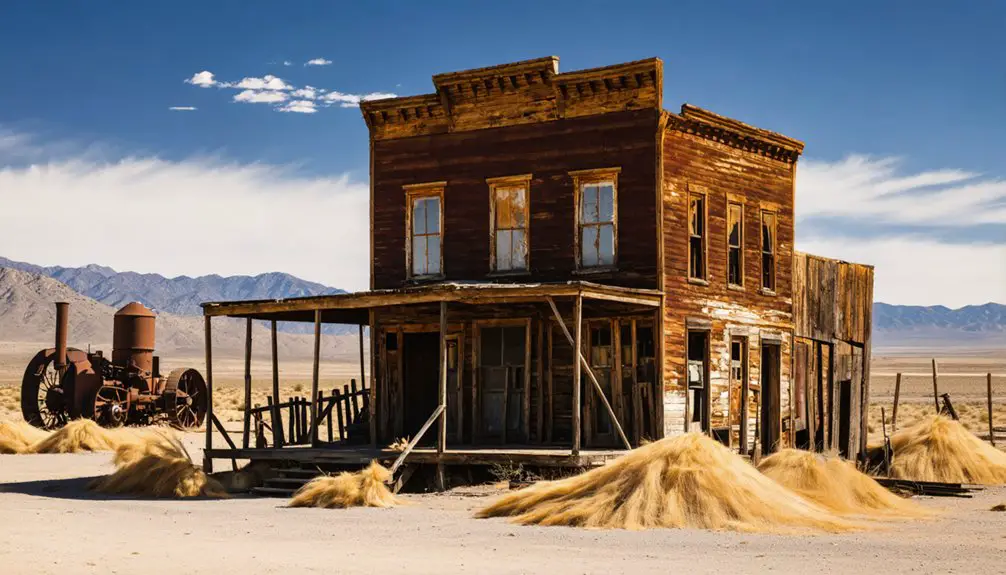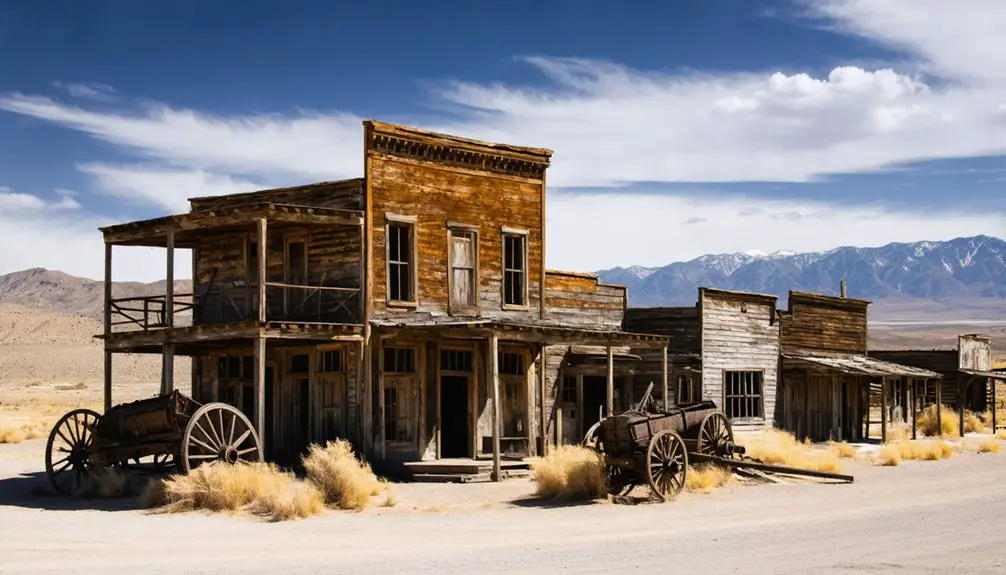You’ll find El Dorado City’s ruins in Nevada’s El Dorado Canyon, where gold fever transformed a barren wash into a bustling settlement of 2,000 residents during the 1860s. The infamous Techatticup Mine anchored the town’s prosperity, yielding millions in precious metals through advanced mining operations. Despite its economic success, the isolated community battled lawlessness and harsh conditions, with the nearest sheriff stationed 200 miles away. The town’s dramatic rise and fall tells a compelling tale of frontier ambition.
Key Takeaways
- El Dorado City was established in the 1860s around Techatticup Mine, growing to 2,000 residents with schools, stores, and a post office.
- The town’s economy thrived on gold mining, with the Techatticup Mine producing over half of Eldorado Canyon’s mineral output.
- Harsh conditions, lawlessness, and isolation characterized life in El Dorado City, with the nearest sheriff stationed 200 miles away.
- The town’s prosperity ended in the early 1900s due to declining ore values and challenging environmental conditions.
- Techatticup Mine’s closure in the 1940s marked El Dorado City’s final transition into a ghost town status.
The Birth of a Mining Boomtown
While many Western mining settlements faded into obscurity, El Dorado City emerged as a significant boomtown in the 1860s at the mouth of January Wash in El Dorado Canyon. The mining community sprang up around the Techatticup Mine, attracting prospectors from California who sought their fortunes in the Colorado Mining District.
El Dorado City rose from the Western frontier, drawing ambitious miners to the Techatticup Mine during the 1860s gold rush.
You’ll find it’s no coincidence that settlers chose the Spanish name “El Dorado,” meaning “the gilded,” for their ambitious venture. The mine went on to produce over $30 million in precious metals during its operation.
The boomtown culture quickly took shape as the population swelled to 2,000 residents. By 1865, you’d have found a bustling town complete with a post office, schools, stores, and even a red-light district. The Spanish explorers had discovered gold in the area as early as 1775, laying the groundwork for future mining operations.
The military’s presence from 1867 to 1869 reinforced the settlement’s importance while protecting crucial riverboat freight routes.
Gold and Silver: The Driving Force
You’ll find that the Techatticup Mine emerged as the powerhouse of Eldorado Canyon, generating more than half of the region’s total mineral production.
The area’s mines yielded an impressive $6 million in gold, silver, copper, and lead ores by 1900, with gold extraction alone reaching $10 million during the peak years between the 1860s and 1900. The Wall Street Mine produced an astounding $1.5 million in gold from just 80 feet of depth.
The introduction of stamp mills and later cyanide processing transformed mining operations, enabling more efficient extraction of precious metals from the region’s rich ore deposits. Mining operations continued steadily until 1945 final closure, marking the end of an era of mineral wealth in the canyon.
Mining’s Economic Impact
As prospectors discovered gold and silver in Eldorado Canyon around 1857, they initiated a mining boom that would generate over $10 million in mineral wealth during its peak period from the mid-1860s to 1900.
The three largest mines – Techatticup, Wall Street, and El Dorado Rand Group – drove this economic prosperity, with Techatticup alone accounting for over half the district’s production. The Wall Street Mine was particularly notable, producing $1,500,000 in gold from its relatively shallow 80-foot depth. Native Americans were the first to extract valuable minerals, collecting rich turquoise deposits long before European explorers arrived.
You’ll find that mining infrastructure evolved to support this wealth generation. The 1883 construction of a 15-stamp mill enhanced economic sustainability by processing ore locally.
Steamboat routes along the Colorado River, stretching 350 miles from the Gulf of California, provided crucial transportation until the railroad’s arrival in 1905.
These developments, combined with military protection of freight routes, created a robust mining economy that persisted through World War II.
Techatticup’s Record Production
The Techatticup Mine emerged as the crown jewel of Eldorado Canyon‘s mining operations, generating millions in gold ore from its opening in the early 1860s until 1945.
The mine’s early success was aided by steamboat service that delivered vital supplies and transported ore along the Colorado River. Operating in the remote desert terrain, the location became a perfect hideout for Civil War deserters seeking refuge from authorities.
You’ll find that innovative mining techniques transformed this operation into a powerhouse, accounting for over half the district’s total production value.
Key features that drove Techatticup’s remarkable gold production:
- Construction of a fifteen-stamp mill in 1883 that slashed processing costs
- Implementation of a cyanide mill near Nelson for enhanced gold extraction
- Installation of a fifty-ton smelter in 1905 for processing complex ores
- Strategic use of steamboats on the Colorado River for ore transport
- Integration of railroad access that revolutionized production efficiency
Despite periodic lawlessness and social turmoil, the mine’s output remained consistently profitable throughout its operational years, processing gold, silver, copper, and lead until the post-WWII era.
Mill Operations Transform Region
Mining operations in El Dorado Canyon underwent a dramatic transformation beginning in 1883 when Techatticup Mining Company built its fifteen-stamp mill, revolutionizing local ore processing capabilities. This mill technology marked the region’s shift from simple extraction to sophisticated processing operations.
You’ll find that subsequent processing advances, including the construction of a 50-ton smelter in 1905 and a cyanide mill in Nelson, dramatically improved the region’s mining efficiency.
These developments allowed miners to extract value from previously unprofitable low-grade ore. The integration of mills and smelters transformed El Dorado Canyon into a complete mining hub, where you could witness every stage of mineral production. Miners worked tirelessly in extensive tunnel networks, some reaching depths of 500 feet below ground.
This industrial evolution, combined with steamboat and railroad connections, established the canyon as a significant economic force, producing over $6 million in precious metals during peak operations. Col. John R. Vineyard pioneered efficient processing in the region by constructing the first ten-stamp mill in late 1863, cutting San Francisco shipping expenses in half.
Life in Eldorado Canyon
You’d have found life in Eldorado Canyon’s mining camps marked by extreme isolation, where supply shortages and harsh conditions tested settlers’ resilience daily.
The camps’ notorious lawlessness stemmed from their remote location, with the nearest sheriff stationed 200 miles away in Pioche during the 1870s, leaving residents to rely on vigilante justice.
The tension between rival camps and frequent disputes over mining claims often erupted into violence, contributing to the area’s reputation as one of the American West’s most dangerous mining districts.
Daily Mining Camp Reality
Life in Eldorado Canyon’s mining camps reflected harsh realities of frontier existence, where miners faced grueling work conditions and social tensions daily.
You’d find yourself working long hours using primitive mining techniques, following ore veins like the Salvage Vein while tunneling into steep hillsides.
- Manual ore extraction dominated your daily routine, with constant risks of cave-ins.
- You’d process ore at stamp mills built onsite to reduce transport costs.
- Your camp survival depended on supplies from steamboats traversing 350 miles upriver.
- You’d live in basic, crowded shelters alongside Civil War deserters and sympathizers.
- Each day brought challenges from extreme weather and equipment failures.
The isolated environment meant you’d rely on fellow miners despite social divisions, making camp survival a communal effort in this untamed frontier setting.
Law and Order Challenges
The stark isolation of Eldorado Canyon created a lawless frontier where justice remained elusive and violence prevailed. You’d find the nearest sheriff stationed 200 miles away in Pioche or Hiko, leaving residents to fend for themselves through vigilante justice.
The absence of law enforcement meant murder and serious crimes often went unpunished, while disputes over mining claims frequently erupted into deadly gunfights.
You couldn’t count on official protection when Native American raids threatened the area, and notorious outlaws like Queho roamed freely.
Even when federal troops established a post in 1867, their presence provided only temporary relief.
The Techatticup Mine became a focal point of violent confrontations, as claim-jumping and labor disputes turned deadly in this untamed environment where might made right.
Rival Camp Tensions
During the Civil War era, three distinct mining camps emerged in Eldorado Canyon, each marked by fierce political divisions and economic rivalries.
Camp rivalries intensified as Confederate-sympathizing Lucky Jim Camp and Union-aligned Buster Falls competed for control over limited resources and profitable mining claims.
- Control of Col. Vineyard’s revolutionary 10-stamp mill sparked intense competition
- Camps fought aggressively over rich mineral deposits, especially along the Salvage Vein
- Limited water, timber, and supply routes fueled resource competition
- Political divisions between Union and Confederate sympathizers heightened tensions
- Social fragmentation deepened through ethnic and cultural differences
While the 1867 arrival of Camp El Dorado’s military presence temporarily subdued conflicts, the underlying rivalries persisted.
Even shared economic dependencies couldn’t fully bridge the divides between camps competing for survival in this harsh, isolated environment.
The Infamous Techatticup Mine
Mining history reached a defining moment when prospectors established Techatticup Mine in 1861, marking the beginning of Southern Nevada’s most profitable mining operation.
You’ll find its name derives from Paiute words meaning “hungry” or “bread,” reflecting the area’s rich indigenous heritage.
Located 39 miles southeast of Las Vegas in the rugged Eldorado Canyon, this powerhouse produced millions in gold, silver, copper, and lead ore.
You’re looking at a complex network of tunnels that generated over half the district’s total ore production.
While mining safety wasn’t always essential, the operation thrived through strategic developments including an on-site 15-stamp mill by 1883 and later, a 50-ton smelter.
Colorado River steamboats proved vital, traversing 350 miles from the Gulf of California to transport essential supplies and ore.
Lawlessness and Wild West Justice

Lawlessness flourished in El Dorado City’s remote canyon lands, where the nearest law enforcement officials operated from distant outposts like Hiko, Nevada – sometimes 200-300 miles away.
The challenging terrain and extreme distances created perfect conditions for frontier lawlessness and vigilante justice, forcing residents to establish their own brand of order.
- Placerville’s “Hangtown” nickname came from swift frontier trials and public executions
- Civil War tensions split mining camps into violent Northern and Southern factions
- Notorious outlaws like Queho, Nevada’s first serial killer, terrorized the region
- Native American raids and conflicts heightened the atmosphere of danger
- Limited law enforcement led to self-policing and community-driven justice
The military’s 1867 establishment of a post offered minimal relief, but the area’s isolation continued to breed a culture where survival often meant taking the law into your own hands.
Notable Characters and Deadly Conflicts
As violence gripped El Dorado City’s canyon lands, several notorious figures emerged who’d shape the region’s deadly reputation.
You’ll find the most infamous among them were Ahvote and Queho, renegade outlaws whose combined body count exceeded 25 victims. Ahvote’s massacre of Charles Nelson and four others in 1897 sent shockwaves through the community, while Queho’s reign of terror lasted until at least 1919, when he killed Maude Douglas near Techatticup Mine.
The canyon’s isolation bred a culture of vigilante justice, where gunfighters like “Bucky” became legendary figures.
Daily gunfights erupted over mine disputes at Techatticup, where valuable ore deposits sparked deadly confrontations between rival factions. Civil War deserters found refuge here, adding to the volatile mix of outlaws and desperate men.
From Prosperity to Abandonment

Despite its wild and violent reputation, El Dorado City flourished in the 1860s, transforming from a remote outpost into a bustling hub of over 2,000 residents at its peak.
The town’s prosperity centered around advanced mining techniques at the legendary Techatticup Mine, which yielded an impressive $30 million in precious metals.
- Built infrastructure including schools, stores, and even a red-light district
- Established efficient ore processing with the El Dorado Mills
- Utilized steamboat transportation on the Colorado River
- Adapted operations by relocating mills closer to the river
- Developed multiple productive claims beyond Techatticup
However, you’ll find that by the early 1900s, declining ore values and harsh conditions began transforming El Dorado City into the ghost town it would become.
The final blow came when the Techatticup Mine closed in the early 1940s, ending an era of mining prosperity.
Exploring the Historic Ruins Today
The remnants of El Dorado City’s mining heritage now stand as a tribute to its bygone prosperity, beckoning visitors to explore its weathered ruins.
You’ll find the historic Techatticup Mine at the heart of your desert exploration, where guided tours reveal the underground workings of Nevada’s mining past.
Throughout the site, abandoned structures tell their stories through decaying bunkhouses, a surviving stamp mill, and scattered mining equipment.
For ghost town photography enthusiasts, the site offers compelling subjects: rusty vintage vehicles, an artfully placed “crashed” airplane, and buildings weathered by time against the stark desert backdrop.
While you’ll need to pay a small fee for access, the authentic experience awaits just 45 minutes from Las Vegas, though you should note that amenities are limited and many structures remain in their natural state of decay.
Frequently Asked Questions
What Is the Best Time of Year to Visit El Dorado City?
Picture yourself under golden sunlight – you’ll find the best weather during spring (March-May) or fall (September-November), when temperatures stay comfortable between 60-80°F, making outdoor exploration and seasonal events most enjoyable.
Are There Any Dangerous Wildlife Encounters Reported in the Ghost Town?
While you’ll need to watch for rattlesnakes, there aren’t any documented dangerous wildlife encounters at the ghost town. Standard wildlife safety practices like staying alert and following marked paths protect you effectively.
How Much Does It Cost to Take a Guided Tour?
Looking for an unforgettable ghost town experience? You’ll pay between $134-159 for standard 4-5 hour guided tours, while longer 11-hour adventures cost around $224. Most tours include transportation and refreshments.
Can Visitors Collect Mineral Specimens or Artifacts From the Site?
You can’t collect minerals or artifacts from this private property. The owners prioritize artifact preservation, and removal is prohibited to maintain the site’s historical integrity and protect its educational value.
Is Overnight Camping Allowed Near the Ghost Town Ruins?
Like desert stars guiding ancient travelers, camping regulations light your way: You can camp overnight but must stay 0.5 miles from roads, 100 feet from ghost town amenities, following 14-day limits in designated areas.
References
- https://www.youtube.com/watch?v=MlH4SKnmgao
- https://en.wikipedia.org/wiki/El_Dorado_City
- https://mikesroadtrip.com/el-dorado-canyon-ghost-town-in-nelson-nevada/
- https://travelnevada.com/ghost-town/exploring-eldorado-canyon/
- https://www.legendsofamerica.com/nv-eldorado/
- https://shpo.nv.gov/nevadas-historical-markers/historical-markers/eldorado-canyon
- https://special.library.unlv.edu/boomtown/counties/clark.php
- https://www.exploratography.com/blog-nv/eldorado-canyon-nelson-ghost-town-nevada
- https://travelnevada.com/mines-prospecting/techatticup-mine/
- https://en.wikipedia.org/wiki/El_Dorado_Canyon_(Nevada)



